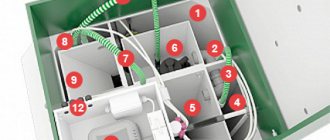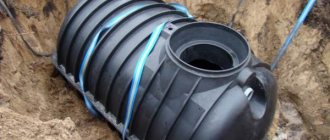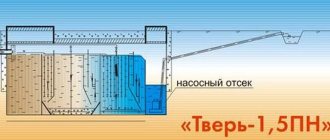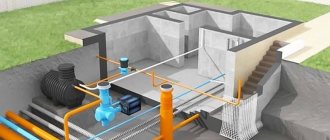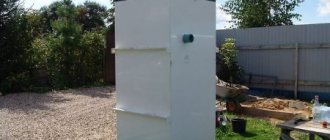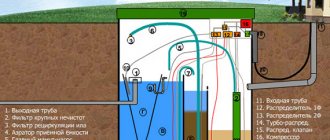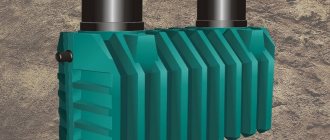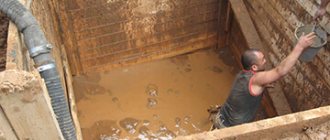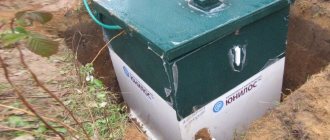Biological treatment stations (BTP) are often called septic tanks, although this is not entirely correct. Septic tanks and stations have common functions - accumulation, purification and disposal of household wastewater. But in other respects they are radically different. They have different materials, designs, operating principles, and, consequently, different cleaning results. And, of course, septic tanks and SBOs differ in installation technology and maintenance. Septic tanks and stations have their pros and cons, and in order to make the right choice, you need to understand a little about the structure and operation of these treatment facilities.
What is a cesspool and how is it constructed?
A cesspool (sewage) is the simplest device for collecting sewage, consisting of a tank with a sealed or absorbent structure. The bottom of the pit is filled with a cement-sand mixture, and the walls are erected from concrete rings, brickwork, or made monolithic.
Finished products made of metal and plastic, which are called cesspool septic tanks, can also be used. Plastic containers are most widespread due to their good tightness and resistance to aggressive environments. The volume of such tanks for a country house or cottage usually varies from 1 to 5 m³, but can reach 60 m³.
Plastic containers for cesspools are made single-chamber. There is an inspection hole at the top. The most widely used materials are polypropylene and polyethylene.
Expert opinion
Ilya Kozhevnikov
Design engineer. 10 years of experience
Order installation of a septic tank
If the groundwater on the site is close to the surface, formwork may be required when digging a pit, which increases the installation cost by at least 20 thousand rubles.
Is it possible to make a cesspool without a bottom?
A cesspool without a bottom can only be used in cases where groundwater is deep. Such a pit cannot be installed closer than 15 meters from the house.
The base of the pit is covered with filter materials (sand, gravel, crushed stone), and the walls can be made of different materials (concrete rings, brick, etc.).
Which option is better?
Comparing the two types of treatment plants, one can understand that it is impossible to give a clear answer to the question of which option is better. When choosing, you must take into account local conditions, you need to take into account:
- operating mode - a house for permanent residence, a summer residence, a place of periodic recreation, etc.;
- the amount of waste generated in the house;
- geology of the site;
- the ability to provide stable, uninterrupted power supply.
As a rule, for a house in which a family lives permanently, it is better to use bio-treatment stations, especially if the water consumption is high. For a summer cottage or recreation center, it is more profitable to use septic tanks.
So, if you need to choose a treatment plant, you need to get acquainted with the pros and cons of each option. In addition, it is necessary to evaluate the operating conditions, as well as conduct a study of the site to study the properties of the soil. Only after this can you make a thoughtful and balanced choice of the optimal option for a particular object.
Flow-through septic tanks and what is Shambo sewerage
They consist of several chambers connected to each other by overflow pipes. When solid waste accumulates in the primary tank, it is also necessary to pump it out with a sludge sucker, but this is done much less frequently. One of the representatives of flow-through septic tanks is the Shambo cesspool.
Wastewater enters the first chamber, where heavy fractions settle at the bottom, and light fractions float to the surface and form a film. In the middle part, clarified waste is collected, which, when replenished, flows into the next chamber. After passing through 2-3 sections, the wastewater is purified up to 60%, but at the same time retains an unpleasant odor and requires additional soil treatment. Therefore, from the last container, liquid waste is transported through pipes to the filtration fields. There they undergo soil purification with a layer of crushed stone and sand, and end up in the ground.
It is possible that the last container of the Shambo septic tank is made without a bottom and serves as a filter well. In this case, the lower surface of the septic tank pit is filled with gravel, and rings are installed on top.
The advantage of flow devices is energy independence. They can be used in houses with non-permanent residence and in summer cottages. However, over time (on average from 2 to 5 years), the soil and drainage layers become silted and stop allowing drainage to pass through, which is why it is necessary to change the layer by adding another ring. Therefore, this method of arranging a shambo pit is considered undesirable.
Installation
This section will discuss how to install an autonomous sewer and septic tank. To do this, detailed instructions with step-by-step actions are provided below. Ideally, each job should be completed in stages. This will ensure correct operation and protect against critical errors.
Installation of a septic tank in a pit can be done with additional reinforcement in the form of reinforcing mesh Source kanalizaciyam.ru
Installation of a septic tank on the site step by step
Since there is a need to construct a system at a summer cottage, in this case the question of what is better: a septic tank or an autonomous sewer system is not appropriate. It is definitely more rational to install a septic tank. In this section you can learn how to install it.
When installing a septic tank, it is necessary to check the structure for absence of slope Source eurolos.ru
Stage one: selection and preparation of installation site
Choosing the right location is already half the success. At this stage, you should be guided by the following factors:
- is it possible for a sewer truck to approach the septic tank for pumping;
- distance from a reservoir, well, water supply system by at least 10 meters;
- the distance from a residential building should not be less than 6 meters, ideally 20 meters;
- It should be possible to lay a straight sewer pipe (without bending);
- the ability to deepen the septic tank so that its intake hole is lower (this will prevent stagnation of waste in the pipe, and as a result, the formation of a blockage).
After deciding the difference between a septic tank and an autonomous sewer system and taking into account the listed factors, you can begin preparing the pit. This process is simple, the most important thing is to correctly determine the size. To do this, you will first have to buy the tank itself and its accessories. Based on the volume of the selected container, you can start digging a pit.
Strengthening the pit for a septic tank can be done using monolithic finishing Source remontnik.ru
It is imperative that when the pit is prepared, it is necessary to install a waste receiving tank in it on the same day. Otherwise, there is a risk that a collapse will occur or the interior will fill with groundwater.
Stage two: features of septic tank installation
It is advisable to install a septic tank with assistants. For this purpose you will need 4 people. It is necessary to thread the ropes into the technological protrusions and then use them to lower the structure into the prepared pit.
Be sure to set it level. To do this, you can stand on top of the septic tank and swing it in different directions to catch the parallel to the bottom. If there is still a slope, you can backfill the bottom of the septic tank with river sand. At the same time, it should be carefully compacted so that there is no overweight in the future.
The next step is to install thick corrugated pipes on the necks, fill the septic tank to the top with water (fill each compartment), and then close the hatches. Add sand into the cracks so that the structure is sealed and does not move randomly.
Important! It is allowed to leave a slope angle of 1 cm per 1 meter of length. This solution is appropriate for both an autonomous sewer system and a septic tank.
The street pipe to the septic tank is laid in insulation if it is laid above the freezing level of the soil Source sdelais.ru
The upper part of the septic tank must be covered with foam plastic so that during periods of severe frost the structure filled with waste does not deform. After the insulation has hardened, you can continue filling it with sand, after which you should pour water over the entire mass in order to create a higher density of the structure inside the pit.
Stage Three: Pipeline Installation
The laying of the pipeline leading to the septic tank is carried out using sewer pipes with a diameter of 110 mm. Please note that the street version will be orange. Models of pipes for wiring in a gray house.
Pull the pipe to the inlet at a slope of 3 cm for each linear meter. In no case should you make the slope steeper, otherwise the water will drain faster than feces, which will lead to stagnation and a gradual narrowing of the lumen in the pipe.
The installation of such an inspection well is mandatory when turning and crossing pipes in the ground Source sdelais.ru
All pipe connections must be made using sealants (special rubber bands). Their number is calculated depending on the number of sewer pipe closures. The pipe running along the street to the waste receptacle does not need insulation, since the liquid inside it does not stagnate. Of course, this is subject to a correctly executed slope and sufficient depth of immersion in the trench.
Stage four: planning the ventilation and drainage system
Ventilation for a septic tank is mandatory, as it will help quickly rid the container of stagnant processes and the spread of unpleasant odors. It happens that the factory septic tank comes with an outlet pipe included. If it is not there, then you will need a long gray sewer pipe with a diameter of 110 mm. You will definitely have to additionally purchase a special end cap with perforation. It may also look like a round lattice. The main thing is that it fits in diameter.
Ventilation for the septic tank is not provided by the factory, but it can be installed at the point where water is discharged into the ground Source bioprime.info
The septic tank ventilation pipe should be installed directly on the tank itself. If the corresponding hole is not provided by the container manufacturer, then ventilation must be installed at the stage of immersing the septic tank in the pit. Please note that the pipe must be raised high enough above ground level so that the air formed inside can escape freely.
On a note! Ventilation for a septic tank system is mandatory. Its presence will prevent the creation of a vacuum during flushing of biological waste. Otherwise, feces may backflow into the bathtub or toilet.
After fully organizing the wastewater system and ventilation in relation to the septic tank, it’s time to think about drainage, namely the method of draining the purified liquid.
The most alternative and financially beneficial option is surface drainage. It is configured as follows:
- A trench is prepared, the length of which is 10 meters, width - 0.4 m, depth - 0.5-0.6 m.
- Geotextiles are laid on top, then a perforated pipe is placed along the entire length of the trench at a slope of 1 cm for each meter of pipe.
- If there is a natural slope in the area where the pipe is laid, then there is no need to give it to the pipe.
- The next step is to secure the edges of the geotextile to the ground with pegs so that they do not curl up.
- Then the filling is done with crushed stone to the very top. It is advisable to use the middle fraction of the material, it will provide better drainage.
All that remains is to cover the trench with soil from above, and a full-fledged septic tank is ready for use.
Installation of autonomous sewage system on site: instructions
Installation of an autonomous sewer system, like a septic tank, is best started by preparing the installation location. The device must be located at a sufficient distance from residential buildings, neighbor’s fence and communications. In each specific case, the listed parameters may vary. Further all actions are performed according to the instructions:
- Prepare the pit according to the installation diagram, with the installation of formwork for your WWTP model.
- Apply sand evenly under the base, at least 150 mm.
- Lay the inlet/outlet pipeline to the entry point into the WWTP in accordance with the building codes.
- Lead the cable to the compressor compartment of the WWTP and insert it through a split HDPE outlet with a diameter of 20 mm.
- Lower the WWTP into the pit and level it horizontally and vertically (maximum deviation 5 mm).
- Cover the waste water treatment plant on all external sides with 300–400 mm of sand (GOST 8736–2014). 8. Fill the WWTP to the same height with water. Fill the WWTP evenly from all sides and at the same time fill it with water 1000 mm from the bottom of the WWTP.
- Make the inlet hole in accordance with the installation diagram; install the supplied pipe and solder it with a welding rod; connect the supply line to the branch pipe through a connecting or compensating coupling. Make an inlet hole in accordance with the installation diagram; install the supplied pipe and solder it with a welding rod; connect the supply line to the branch pipe through a connecting or compensating coupling.
- Lay a purified water pipeline to the discharge point.
- In WWTP models with a gravity outlet, connect the outlet pipe to the purified water drainage pipeline. In installations with forced discharge, make a Ø 25 or Ø 32 hole in either direction in the direction of discharge of purified water, insert the supplied pipe and seal it with a welding rod.
- Install and connect equipment to the installation.
- Cover the WWTP with sand to the ground level.
For biological treatment plants, all possible options for the removal of purified water are applicable in compliance with regulatory documents regarding placement, taking into account the type of soil.
The installed autonomous sewage system should not be completely immersed in the ground Source septikdom.com
After studying the installation principles, everyone will be able to decide for themselves whether a septic tank or an autonomous sewage system is better and for what conditions.
What are VOC AND AU
Local treatment facilities (LTP) are a deep biological treatment station that uses bacteria. Microflora can be created naturally or started artificially. They are characterized by compactness and a high degree of purification: up to 95-98%.
VOCs and aeration units are the most effective devices for autonomous sewerage. The high degree of purification allows the discharged water to be used for washing cars and watering lawns. Their common drawback is energy dependence.
Local treatment plants can be used periodically. Long breaks in operation do not affect their filtering ability, and even after six months of inactivity, VOC can effectively clean wastewater.
ACs are more demanding in terms of operating conditions. Just 8 hours of lack of electricity can lead to the death of biobacteria, after which the installation will return to normal mode for about a week.
All this time, the wastewater will not be treated enough to be discharged onto open ground. But if the correct operating mode is observed, their degree of purification is higher than that of VOCs.
Also, aeration units need to be preserved for the winter (if they are not planned to be used).
Expert opinion
Ilya Kozhevnikov
Design engineer. 10 years of experience
Order installation of a septic tank
When choosing a local treatment plant, you should take into account not only its productivity, but also the maximum permissible burst discharge, which is limited due to the small size of VOCs.
RESULTS OF COMPARISONS
Bearing in mind the quality of the final products formed after treatment, a comparison between a septic tank and a biological treatment station will be in favor of the latter. Here, the output is clean industrial water, suitable for watering flowers, lawns and which is always useful in everyday life, for example, for cleaning sidewalks, washing the facade of a house, car or garden equipment. And if there is an excess, it can be poured into the ground without danger to others. This cannot be done after a septic tank, and even the apparently cleared liquid from the last tank requires additional purification!
Differences between a septic tank and a cesspool
- The first difference between a septic tank and a cesspool is wastewater treatment. If a cesspool-type sewer system serves only to store sewage, then septic tanks or VOCs (even better) can process household waste.
- Sewage pits are a source of unpleasant odor, while many bioseptic tank designs make it possible to neutralize it through the use of microorganisms.
- In terms of environmental impact, septic tanks also differ for the better.
- Sewage cesspools require periodic cleaning with vacuum cleaners. Flow-through septic tanks, by the way, are also susceptible to this drawback. But they need to be pumped out much less often. But VOCs or ACs process sewage into sludge, which has no toxic effects and can often be removed without the involvement of outside help.
How important are wastewater treatment plants in the home?
Disposal of household waste is the number one task for the private sector. And the fact that you can’t do this without special equipment is clear to everyone. Indeed, today in the process of washing, cleaning, and washing dishes, various chemicals are used. If they get into groundwater or soil, they are harmful to the environment.
Therefore, in areas where there is no central sewerage system, it is necessary to arrange autonomous systems. Otherwise, it is impossible to achieve comfortable living conditions in a private home.
Comparative analysis of septic tanks and biological treatment stations
The advantages and disadvantages of different types of septic tanks and VOCs are given in the table:
| Type of septic tank | Design Features | Operating principle and degree of purification | Cost of equipment without installation | Advantages | Flaws |
| Cumulative | Works on the principle of “cesspools” Have one block and a pipe leading to it Require frequent pumping with a sewer truck | Accumulates Degree of purification 0% | 15 000 – 70,000 rub. | -Budget option -Possible independent device | -Not environmentally friendly -Expensive to operate (often requires pumping with a sewer machine) -No wastewater treatment |
| Settling tanks (overflow) | They have a multi-stage design consisting of several containers with overflow pipes. Requires installation of additional cleaning systems. | Accumulates and defends. Degree of purification up to 60% | 25 000 – 80,000 rub. | -Relatively budget option -Not difficult to use - Does not require electricity | - Requires the installation of soil water purification - Possible release of unpleasant odors. |
| VOC | A single sealed multi-section unit with inlet and outlet pipelines. Performs wastewater treatment. Requires electricity. | Accumulates, defends and cleanses Degree of purification up to 98% | 45 000 – RUB 250,000 | -Environmentally friendly -High degree of purification -No unpleasant odors | -Initial cash outlay required -powered by electricity |
Popular septic tank models and their characteristics:
| Topas | Eurolos | Unilos | Biodeck | |||
| BIO | PRO | Priming | ||||
| How many people is it designed for? | 4 — 150 | 3 — 20 | 3 — 30 | 3 — 32 | 3 — 300 | 3 — 20 |
| Salvo discharge, l | 175 — 4500 | 150 — 1100 | 150 — 1600 | 150 — 1600 | 150 — 6000 | 140 — 950 |
| Productivity, m3/day | 0,8 — 24 | 0,6 — 4 | 0,6 -6 | 0,6 — 6 | 0,6 — 60 | 0,5 — 4 |
| Weight, kg | 210 — 3085 | 127 — 383 | 119 — 409 | 149 — 641 | 135 — 5600 | 107 — 320 |
| Dimensions (length*width*height), m | 0,95*0,95*2,5 — 4,2*4,4*3,1 | 1,4*1,4*1,8 — 2,3*2,3*2,7 | 1,3*1,3*1,8 — 2,1*2,1*2,75 | 1,5*1,2*1,7 — 13,5*1,2*1,7 | 1,12*0,94* 2,12 — 4*2,16* 3,21 | 1,06*1,06*1,84 — 2,16*2,16*3,07 |
Topas
The septic tank is made in a polypropylene rectangular body. Household wastewater is treated biologically together with bubble aeration. Adding bacteria is not required. There are 2 modifications of Topas - with gravity and forced discharge of water.
Prices for septic tanks Topas
- Compressor septic tanks
- Topas
Septic tank Topas 4
RUB 108,500
- Number of people: 4
- Salvo discharge: 175 l
- Pipe depth: 85 cm
- Dimensions: 880 x 970 x 2600 mm
- Installation price: RUB 26,000
Order
- Compressor septic tanks
- Topas
Septic tank Topas 5
129,000 rub.
- Number of people: 5
- Salvo discharge: 220 l
- Pipe depth: 85 cm
- Dimensions: 1150 x 1170 x 2500 mm
- Installation price: RUB 27,000
Order
- Compressor septic tanks
- Topas
Septic tank Topas 6
131,000 rub.
- Number of people: 6
- Salvo discharge: 250 l
- Pipe depth: 55 cm
- Dimensions: 1080 x 1170 x 2600 mm
- Installation price: RUB 28,000
Order
Eurolos
The Eurolos company produces a whole range of bioseptics:
- BIO
- PRO
- PRIMING
The products are made in a cylindrical body, due to which they have low weight and increased rigidity.
Eurolos BIO
It combines biological treatment with bacteria and mechanical aeration, due to which the degree of filtration is higher than that of classic septic tanks. The main design feature is a jet ejector, which allows you to combine the functions of a drip biofilter and a mechanical aerator.
Prices for septic tanks Eurolos BIO
- Eurolos
- Pumping septic tanks
Septic tank Eurolos BIO-4
RUB 81,500
- Number of people: 4
- Salvo discharge: 180 l (model Eurolos BIO 4+)
- Pipe depth: 66 cm
- Dimensions: 1400 x 1900 mm
- Installation price: RUB 24,000
Order
- Eurolos
- Pumping septic tanks
Autonomous sewage system Eurolos BIO-3
RUB 77,140
- Number of people: 3
- Salvo discharge: 150 l (model Eurolos BIO 3+)
- Pipe depth: 66 cm
- Dimensions: 1400 x 1800 mm
- Installation price: RUB 23,000
Order
- Eurolos
- Pumping septic tanks
Septic tank Eurolos BIO-5
RUB 87,590
- Number of people: 5
- Salvo discharge: 210 l (model Eurolos BIO 5+)
- Pipe depth: 66 cm
- Dimensions: 1400 x 2000 mm
- Installation price: RUB 25,000
Order
Air supply capacity reaches 40 liters per minute. The biofilter uses loading material with a spatial cylindrical shape, which reduces the likelihood of fouling, which avoids periodic washings.
Eurolos PRO
Aeration unit with a high degree of maintainability. During production, the maximum number of standardized parts that can be purchased at a hardware store is used. Maintenance frequency is once a year.
Prices for septic tanks Eurolos PRO
- Eurolos
- Compressor septic tanks
Septic tank Eurolos PRO 3
RUB 82,200
- Number of people: 3
- Salvo discharge: 150 l (model Eurolos PRO 3+)
- Pipe depth: 66 cm
- Dimensions: 1800 x 1270 mm
- Installation price: RUB 23,000
Order
- Eurolos
- Compressor septic tanks
Septic tank Eurolos PRO 4
RUB 89,900
- Number of people: 4
- Salvo discharge: 180 l (model with forced pumping 4+)
- Pipe depth: 66 cm
- Dimensions: 1900 x 1270 mm
- Installation price: RUB 27,000
Order
- Eurolos
- Compressor septic tanks
Septic tank Eurolos PRO 6
RUB 105,550
- Number of people: 6
- Salvo release: 270 l (for model with forced release 6+)
- Pipe depth: 66 cm
- Dimensions: 2000 x 1400 mm
- Installation price: 29,000 rub.
Order
Eurolos Ground
Designed for use in conditions of high groundwater. The septic tank can be retrofitted with a UV disinfection unit, so the purified water can be used for watering plants.
Soil - prices for popular sizes
- Eurolos
- Compressor septic tanks
Septic tank Eurolos GRUN 3
RUB 111,150
- Number of people: 4
- Salvo discharge: 150 l (model Eurolos Grunt 3+)
- Pipe depth: 50 cm
- Dimensions: 1500 x 1200 mm
- Installation price: RUB 26,000
Order
- Eurolos
- Compressor septic tanks
Septic tank Eurolos GRUNT 4
RUB 117,300
- Number of people: 4-5
- Salvo discharge: 180 l (model Eurolos Grunt 4+)
- Pipe depth: 50 cm
- Dimensions: 2000 x 1200 mm
- Installation price: RUB 28,000
Order
- Eurolos
- Compressor septic tanks
Septic tank Eurolos GRUN 5
RUB 130,700
- Number of people: 5-6
- Salvo discharge: 210 l (model Eurolos Grunt 5+)
- Pipe depth: 50 cm
- Dimensions: 2500 x 1200 mm
- Installation price: RUB 32,000
Order
Unilos
Unilos ASTRA stations can be one or two compressor. The latter are used for deep sewer pipes. Bacteria are naturally bred inside for 2 to 4 weeks.
Price of septic tank Unilos Astra
- Compressor septic tanks
- Unilos
Septic tank Unilos Astra 3
RUB 86,400
- Number of people: 4
- Salvo discharge: 150 l
- Pipe depth: 85 cm
- Dimensions: 1120 x 940 x 2000 mm
- Installation price: RUB 26,000
Order
- Compressor septic tanks
- Unilos
Septic tank Unilos Astra 5
RUB 108,500
- Number of people: 4
- Salvo discharge: 250 l
- Pipe depth: 85 cm
- Dimensions: 1030 x 2360 x 1120 mm
- Installation price: RUB 27,000
Order
- Compressor septic tanks
- Unilos
Septic tank Unilos Astra 8
RUB 130,500
- Number of people: 8
- Salvo discharge: 350 l
- Pipe depth: 85 cm
- Dimensions: 1500 x 1160 x 2360 mm
- Installation price: RUB 30,000
Order
Expert opinion
Ilya Kozhevnikov
Design engineer. 10 years of experience
Order installation of a septic tank
To speed up the process of bacteria accumulation in AC, you can start them artificially. For this purpose, there are special biological preparations “Start”, which in a diluted state must be flushed through the toilet.
Biodeck
Biodeka septic tanks are lightweight and compact in size. They work on the principle of aeration units. There are modifications with self-rejection and forced reset. Service can be performed directly by the owners, as it does not require special technical skills.


